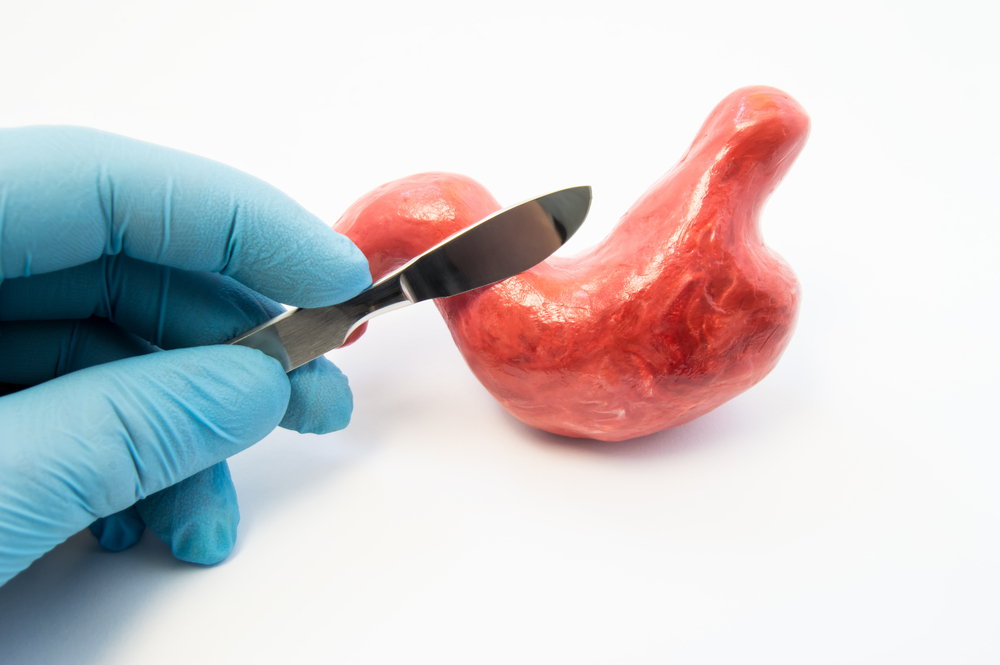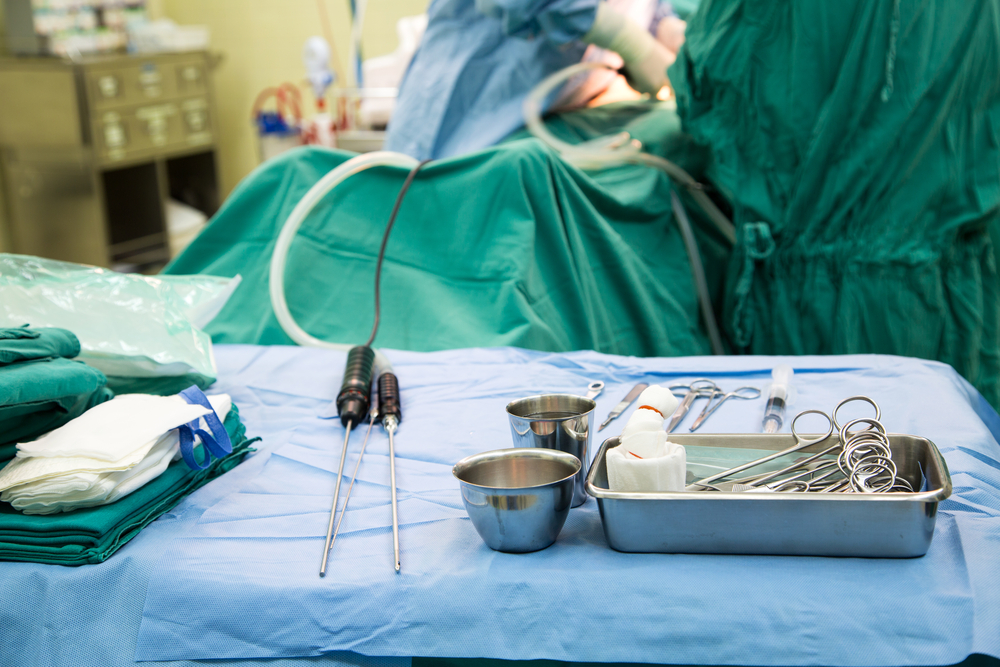- Duodenal switch surgery is a unique procedure that makes the stomach smaller and re-routes the intestines.
- Patients who follow the post-surgery instructions can expect to see significant weight loss (about 70 percent of excess fat within two years).
- The invasive nature of the procedure and risk of complications, coupled with a relatively lengthy recovery time, make it less than ideal for some candidates.
What is Duodenal Switch Surgery?
Duodenal switch surgery, also known as biliopancreatic diversion with duodenal switch (BPD-DS) or gastric reduction duodenal switch (GRDS), is a two-part bariatric surgery that helps patients reduce hunger, lose weight, and treat conditions such as sleep apnea and diabetes.
The procedure is considered both restrictive (it restricts the amount of food consumed by reducing the stomach’s capacity) and malabsorptive (it helps the body absorb fewer calories by rerouting the intestines). This is achieved in three stages:
1. Reducing Stomach Size — The restrictive element of BPD-DS is a result of a procedure named vertical sleeve gastrectomy (VSG). Doctors typically remove at least 70 percent of the stomach, which lowers hunger and helps patients feel fuller sooner. Stomach tissue produces the hormone ghrelin, which is responsible for ‘hunger pains’. With less ghrelin, the appetite is suppressed.
9 to 12 months following surgery, the stomach will begin to stretch, increasing its capacity for more food. However, patients generally continue to consume about 50 percent less than they did pre-surgery, preventing the weight they lost from returning.
2. Intestinal Rerouting — The malabsorptive component of the duodenal switch operation is due to intestinal rerouting, or biliopancreatic diversion. The surgeons cuts a small portion of the intestine and re-attaches it further down the digestive tract. This prevents food from meeting up with the digestive juices and being absorbed by the body until it reaches the end of the small intestine, thus promoting weight loss.
3. Removal of the Gallbladder or Appendix — Not all duodenal switch patients will need to have their gallbladder or appendix removed, but in some cases gallbladder removal is recommended in order to reduce the occurrence of gallstones, which form in roughly 50 percent of patients following rapid weight loss.
Doctors may also recommend the removal of the appendix if it is in questionable shape, or as a preventative measure due to its close proximity to the intestines.
Ideal Candidates
Although it is usually performed on patients who have a failed gastric band procedure (sleeve gastrectomy), duodenal switch surgery is also used to treat those who suffer from morbid obesity, as well as obesity-related co-morbidities such as sleep apnea, hypertension, and diabetes.
Patients with Type 2 diabetes who undergo the procedure experience a cure rate of 98 percent, while patients with sleep apnea experience an 82 percent improvement. In other words, the combination of these surgical procedures can almost completely cure diabetes, and dramatically improve sleep apnea. Both of these conditions are associated with cardiovascular disease, including heart attacks.
Not all people with diabetes, morbid obesity, sleep apnea, or other obesity-related conditions qualify for the surgery. To undergo the procedure, patients must typically have a 40-plus BMI (body mass index), and may need to demonstrate that they have one or more of the following co-morbidities:
- Sleep apnea
- Cardiovascular disease
- Diabetes
- Depression
- Polycystic ovarian syndrome (PCOS)
- Other conditions that cause obesity or are a result of obesity
There is no cap on how high the patient’s BMI needs to be. In fact, results may actually be more dramatic in patients with a BMI of 55 or higher. Surgery is generally not recommended for high-risk individuals like smokers, and may not be recommended for those with blood clotting disorders.
Recovery and Post-Surgical Diet
The procedure typically lasts between four and five hours. General anesthesia is used so the patient is unconscious and feels no pain.
Doctors may use the traditional method of creating a large incision in the abdomen, but more often duodenal switch surgeries are performed using a laparoscope, often called ‘belly-button’ surgery. When performed laparoscopically, a surgeon will insert a small camera-attached instrument through a small incision in the abdomen, which can shorten recovery time compared to the traditional, larger incisional method.
Most patients are required to stay in the hospital for three and five days following the procedure so that doctors can closely monitor their recovery. Following surgery, patients are required to drink only fluids and pureed foods for several days before solids are introduced.
Patients are typically able to return to work within one to three weeks after laparoscopic surgery, and six weeks or longer after the traditional surgery. They must stick to a restricted diet, take supplements and vitamins, and exercise regularly for life after recovering from surgery.
Duodenal Switch Risks and Side Effects
Because BPD-DS is an advanced and extensive surgical procedure, it presents a host of risks, complications, and side effects, primarily affecting the bowel.
As previously mentioned, many patients who undergo BPD-DS or gastric bypass surgery will develop gallstones as a result of significant weight loss. Other possible complications include bowel obstruction, diarrhea, constipation, dysphagia (difficulty swallowing), blood clots, bleeding, infection, wound separation, and stomach leakage.
Additionally, patients may experience the ‘dumping syndrome’ or rapid gastric emptying, which causes abdominal cramps and diarrhea 10 to 30 minutes after eating. Fortunately, however, there are medications to address these concerns.
There are also several long-term risks and concerns associated with the procedure, including vitamin deficiency and malnutrition. Because the rerouting of the intestines can lower caloric absorption — which includes proteins, carbohydrates, vitamins and nutrients that are essential for a healthy diet — patients are required to take life-long supplements following a duodenal switch procedure.
Others may develop osteoporosis due to the lack of absorption of calcium and vitamin D, or chronic diarrhea that occurs because the shorter digestive tract doesn’t allow for food to digest properly. Additionally, patients often report issues with excess and sagging skin, which can be corrected with plastic surgery, laser treatments and other methods.
Cost
One of the biggest obstacles to BPD-DS is its cost. A standard duodenal switch procedure costs $27,000 on average, and patients who require gallbladder or appendix removal surgery can expect to pay more.
Fortunately, many duodenal switch patients can have the procedure covered by insurance, especially if they suffer from co-morbidities such as diabetes or sleep apnea. In most cases, if the patient’s insurance covers gastric bypass, it’s likely to cover BPD-DS as well.
Duodenal Switch Surgery vs. Gastric Bypass
Both procedures are effective in helping patients lose weight, but each has its pros and cons.
Duodenal switch and gastric bypass surgeries are similar in that they both leave patients with a smaller stomach, and reduce the amount of the ghrelin hormone produced by the body. However, the intestines are not affected after gastric bypass (also known as vertical gastrectomy or gastric sleeve surgery), so there is no malabsorption.
While duodenal switch can help patients lose more weight than a gastric bypass alone, it comes with many more risks and side effects. In fact, duodenal switch is sometimes regarded as the “extreme version” of gastric bypass. Because the standard gastric sleeve procedure doesn’t require the re-routing of the intestines, it comes with fewer long-term risks.
Patients generally don’t experience malnutrition or vitamin deficiency with gastric sleeve procedures, which is a more common following duodenal switch surgery. Gastric sleeve recovery time is also more manageable, as it requires a shorter hospital stay and fewer follow-up visits. However, gastric bypass patients often experience the ‘dumping syndrome’, bleeding, bloating, bowel disturbances, and in rare cases, even obstruction.
Which Brings Better Results?
According to studies, duodenal switch patients experience more weight loss. In fact, one clinical study demonstrated that duodenal switch patients experienced an average loss of about 22 BMI points, while those who underwent gastric bypass shed 14 BMI points on average.
Overall, approximately 60 percent of gastric sleeve patients experience significant weight loss, while 70 percent of BPD-DS patients lose enough weight for the procedure to be considered successful. BPD-DS may therefore be a better choice for morbidly obese patients, as long as they’re healthy enough to undergo intensive surgery. The lower BMI and higher weight loss translates into reduced morbidity, healthier lives, lower mortality rates, and fewer future health complications such as hip or knee replacements.









